- Trang chủ
- Về chúng tôi
- Ngành
- Dịch vụ
- Đọc
- Liên hệ với chúng tôi
Thị trường Điều trị Rối loạn Sử dụng Opioid (OUD): Phân tích Hiện tại và Dự báo (2024-2032)
Nhấn mạnh vào Nhóm Thuốc (Buprenorphine, Methadone và Naltrexone); Đường Dùng Thuốc (Đường Uống và Đường Tiêm); Kênh Phân Phối (Nhà Thuốc Bệnh Viện, Nhà Thuốc Bán Lẻ & Cửa Hàng, và Nhà Thuốc Trực Tuyến); và Khu vực/Quốc gia
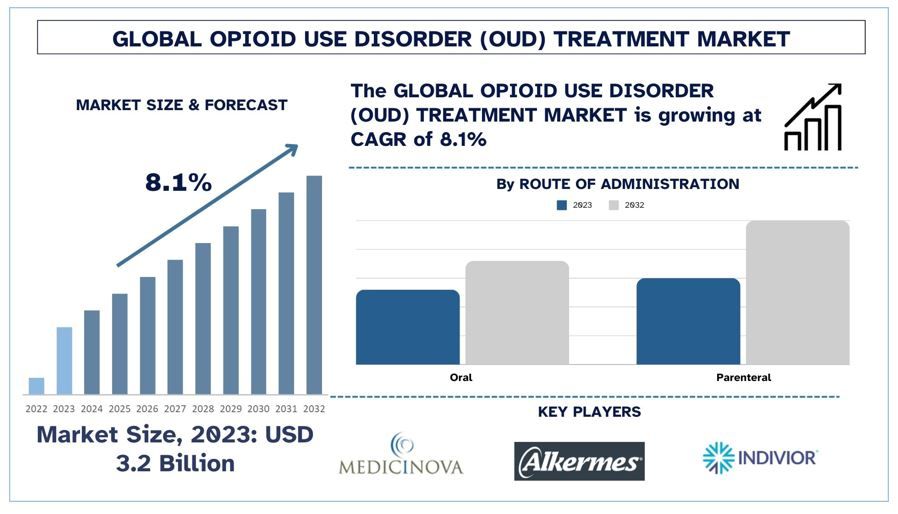 Quy mô & Dự báo Thị trường Điều trị Rối loạn Sử dụng Opioid (OUD)
Quy mô & Dự báo Thị trường Điều trị Rối loạn Sử dụng Opioid (OUD)
Thị trường điều trị rối loạn sử dụng opioid (OUD) được định giá xấp xỉ ~3,2 tỷ đô la Mỹ vào năm 2023 và dự kiến sẽ tăng trưởng với tốc độ CAGR mạnh mẽ khoảng 8,1% trong giai đoạn dự báo (2024-2032) do sự gia tăng của các chiến dịch nâng cao nhận thức về thuốc & các chương trình phòng ngừa liên quan.
Phân tích Thị trường Điều trị Rối loạn Sử dụng Opioid (OUD)
Thị trường điều trị OUD đang phát triển rất nhanh do cuộc khủng hoảng opioid và sự đa dạng của các phương pháp điều trị góp phần vào sự phát triển của thị trường này. Thị trường này bao gồm các phương pháp điều trị bằng thuốc như methadone, buprenorphine và naltrexone, những loại thuốc này phổ biến vì khả năng giúp giảm các triệu chứng cai nghiện và tỷ lệ tái nghiện một cách hiệu quả. Cùng với MAT, có các liệu pháp hành vi và can thiệp tâm lý xã hội giúp tăng cường điều trị. Sự tăng trưởng của thị trường cũng có thể là do tăng cường nhận thức của người dân, sự tham gia của chính phủ và tài trợ cho việc phòng ngừa và chống lại sự phụ thuộc vào chất gây nghiện.
Vào tháng 7 năm 2024, Cơ quan Quản lý Thực phẩm và Dược phẩm đã khởi động một chương trình giáo dục mới có tên “Kê đơn một cách tự tin” nhằm giúp các nhà cung cấp xác định và điều trị rối loạn sử dụng opioid (OUD).
Vào tháng 4 năm 2024, Trung tâm Khoa học Y tế Đại học Texas tại San Antonio (UT Health San Antonio) đang thành lập Viện Be Well về Sử dụng Chất gây nghiện và các Rối loạn Liên quan, một sáng kiến tiên phong dành riêng cho việc thúc đẩy nghiên cứu, giáo dục và các phương pháp điều trị dựa trên bằng chứng.
Xu hướng Thị trường Điều trị Rối loạn Sử dụng Opioid (OUD)
Phần này thảo luận về các xu hướng thị trường chính đang ảnh hưởng đến các phân khúc khác nhau của thị trường điều trị rối loạn sử dụng opioid (OUD), theo xác định của nhóm chuyên gia nghiên cứu của chúng tôi.
Phân khúc Đường tiêm Biến đổi Ngành
Phân khúc đường tiêm trong thị trường điều trị rối loạn sử dụng opioid (OUD) đã trải qua một sự nâng cấp đáng kể do hiệu quả và thời gian sử dụng lâu hơn của các sản phẩm tiêm. Các loại thuốc khác như Naltrexone giải phóng kéo dài (Vivitrol) Series được nhiều người theo dõi do các chất ức chế thụ thể opioid tác dụng lâu dài, giúp giảm cảm giác thèm muốn và giúp tránh giai đoạn tái nghiện. Sự tăng trưởng của phân khúc này cũng được hỗ trợ bởi những cải tiến trong công nghệ bào chế cũng như sự chứng thực ngày càng tăng của các bác sĩ lâm sàng liên quan đến sự tuân thủ và hiệu quả tuyệt vời của chúng trong việc giải quyết OUD. Hơn nữa, xu hướng sử dụng các chế độ điều trị đa chiều và sự tuân thủ của bệnh nhân cũng đã góp phần vào việc tăng cường các phương pháp điều trị đường tiêm để quản lý toàn bộ OUD, tiếp tục thúc đẩy vai trò của nó trong việc quản lý OUD.
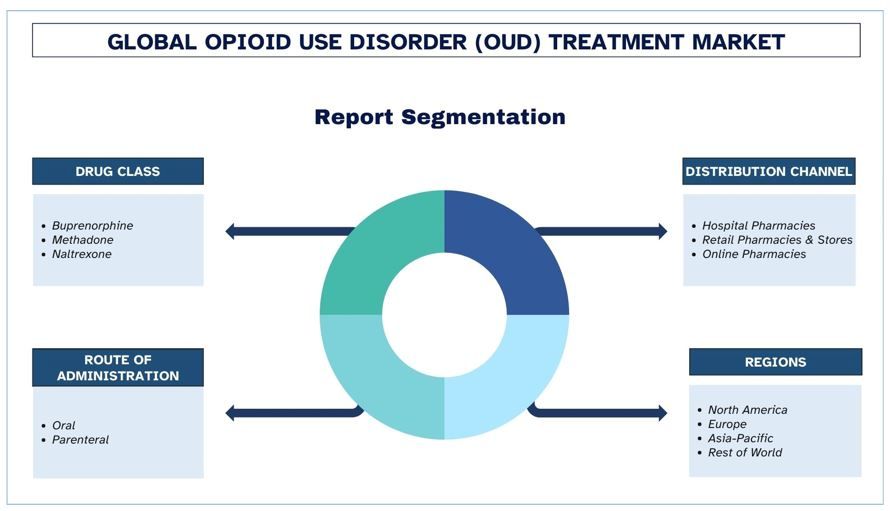
Bắc Mỹ thống trị thị trường vào năm 2023
Thị trường điều trị OUD của Bắc Mỹ đã tăng trưởng ổn định trong những năm qua do nhận thức ngày càng tăng về OUD, sự gia tăng lạm dụng opioid và sự phát triển chung của lĩnh vực chăm sóc sức khỏe. Tỷ lệ nghiện opioid ngày càng tăng ở các quốc gia trong khu vực này đã dẫn đến sự gia tăng đáng kể cả trong liệu pháp hỗ trợ bằng thuốc và liệu pháp hành vi. Có sự nhấn mạnh ngày càng tăng vào hành động của chính phủ và các quan hệ đối tác quốc tế khi họ tìm cách mở rộng khả năng tiếp cận các chế độ điều trị thích hợp, bao gồm buprenorphine và naltrexone, và các phương thức chăm sóc. Hơn nữa, công nghệ nâng cao trong telemedicine và các nhà thuốc trực tuyến đã cho phép bệnh nhân dễ dàng tiếp cận thuốc, do đó góp phần vào sự tăng trưởng của thị trường. Sự mở rộng này là một dấu hiệu cho thấy những nỗ lực giải quyết tình hình với opioid và nâng cao khả năng chăm sóc bệnh nhân trên khắp các quốc gia Bắc Mỹ khác nhau.
Vào tháng 4 năm 2024, Ophelia, một phòng khám bác sĩ điều trị chứng nghiện opioid, đã được Bộ Dịch vụ Nhân sinh của Pennsylvania chỉ định là Trung tâm Xuất sắc (COE) về Rối loạn Sử dụng Opioid (OUD), trở thành COE ảo đầu tiên và trên toàn tiểu bang. Ophelia sử dụng mô hình chăm sóc ảo trước tiên để cải thiện khả năng tiếp cận và duy trì trong điều trị OUD dựa trên bằng chứng bằng cách giảm các rào cản đối với việc chăm sóc cho các quần thể bệnh nhân ở vùng nông thôn, chưa được phục vụ và bị kỳ thị trong lịch sử. Kể từ khi gia nhập Pennsylvania vào năm 2020, nó đã phục vụ hàng ngàn người hưởng Medicaid trong tiểu bang.
Vào tháng 10 năm 2021, Groups Recover Together (Groups) có trụ sở tại Hoa Kỳ, công ty dẫn đầu quốc gia về chăm sóc dựa trên giá trị để điều trị chứng nghiện opioid, đã công bố ra mắt một nền tảng kỹ thuật số độc quyền cho các thành viên của họ. Nền tảng này, một trải nghiệm tập trung vào ứng dụng cung cấp đầy đủ các dịch vụ của Group và được thiết kế để đơn giản hóa trải nghiệm của thành viên, tự hào có các tính năng xung quanh tự lên lịch, tiếp cận, nội dung theo ngữ cảnh, lập kế hoạch điều trị, trị liệu nhóm, thanh toán, biểu mẫu và hơn thế nữa.
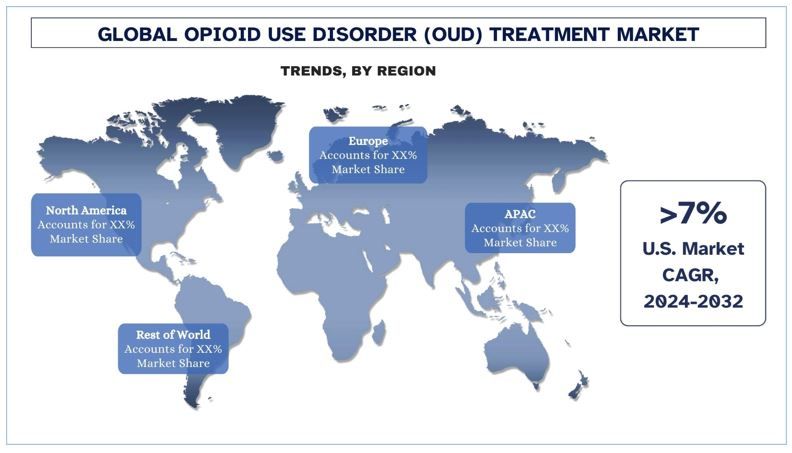
Tổng quan về Ngành Điều trị Rối loạn Sử dụng Opioid (OUD)
Thị trường điều trị rối loạn sử dụng opioid (OUD) mang tính cạnh tranh, với một số người chơi thị trường toàn cầu và quốc tế. Các công ty chủ chốt đang áp dụng các chiến lược tăng trưởng khác nhau để tăng cường sự hiện diện trên thị trường, chẳng hạn như quan hệ đối tác, thỏa thuận, hợp tác, mở rộng địa lý và sáp nhập và mua lại. Một số công ty lớn hoạt động trên thị trường là MediciNova, Inc.; Aphios Corporation; Braeburn Inc.; Alkermes; Indivior PLC; Zynerba Pharmaceuticals, Inc.; Mylan N.V.; Janssen Global Services, LLC; Sandoz AG; Cumberland Pharmaceuticals Inc.
Vào tháng 7 năm 2024, nhà cung cấp OUD ảo Bicycle Health đã ra mắt một chương trình dành cho thanh thiếu niên từ 16 và 17 tuổi sống ở Maine, cung cấp cho họ phương pháp điều trị ảo và tiếp cận các loại thuốc dựa trên bằng chứng cho chứng rối loạn sử dụng opioid (MOUDs).
Vào tháng 4 năm 2022, Pear Therapeutics đã ra mắt một chương trình để cung cấp cho người dùng liệu pháp kỹ thuật số quyền truy cập vào nhà cung cấp dịch vụ telehealth. Chương trình của Pear có trụ sở tại Boston cung cấp cho bệnh nhân đang tìm kiếm phương pháp điều trị rối loạn sử dụng chất kích thích (SUD) hoặc rối loạn sử dụng opioid (OUD) quyền truy cập vào nhà cung cấp dịch vụ telehealth thông qua "công cụ tìm nhà cung cấp" của mình, cũng như các tùy chọn chăm sóc trực tiếp.
Phạm vi Báo cáo Thị trường Điều trị Rối loạn Sử dụng Opioid (OUD)
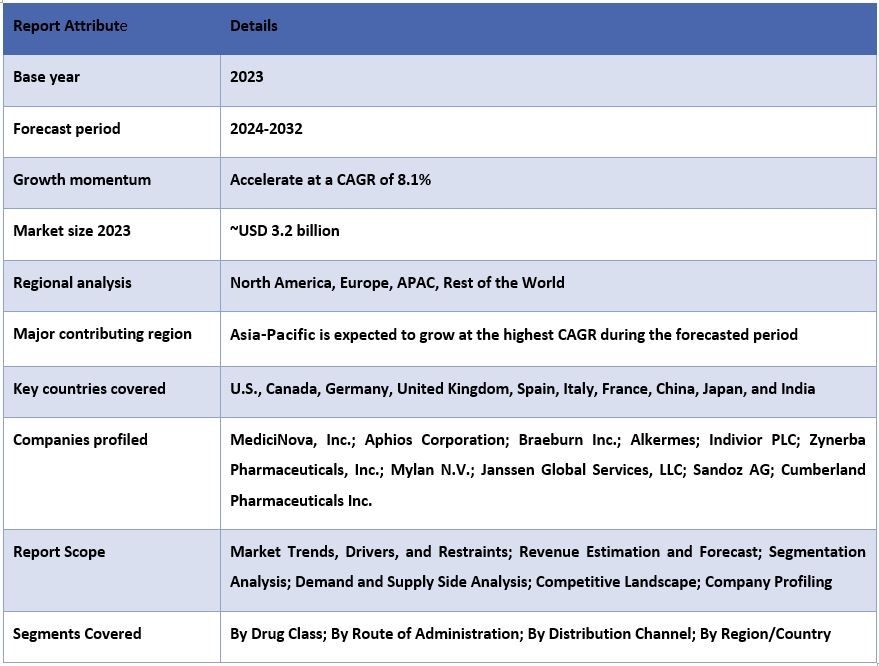
Lý do nên mua báo cáo này:
- Nghiên cứu bao gồm phân tích định cỡ và dự báo thị trường được xác thực bởi các chuyên gia ngành chủ chốt đã được xác thực.
- Báo cáo trình bày một đánh giá nhanh về hiệu suất tổng thể của ngành trong nháy mắt.
- Báo cáo bao gồm một phân tích chuyên sâu về các đồng nghiệp nổi bật trong ngành với trọng tâm chính vào tài chính kinh doanh chính, danh mục sản phẩm, chiến lược mở rộng và các phát triển gần đây.
- Kiểm tra chi tiết các động lực, hạn chế, xu hướng chính và cơ hội hiện hành trong ngành.
- Nghiên cứu bao quát toàn diện thị trường trên các phân khúc khác nhau.
- Phân tích sâu sắc ở cấp độ khu vực của ngành.
Tùy chọn Tùy chỉnh:
Thị trường điều trị rối loạn sử dụng opioid (OUD) toàn cầu có thể được tùy chỉnh thêm theo yêu cầu hoặc bất kỳ phân khúc thị trường nào khác. Bên cạnh đó, UMI hiểu rằng bạn có thể có nhu cầu kinh doanh riêng, vì vậy hãy thoải mái kết nối với chúng tôi để nhận được một báo cáo hoàn toàn phù hợp với yêu cầu của bạn.
Mục lục
Phương pháp Nghiên cứu cho Phân tích Thị trường Điều trị Rối loạn Sử dụng Opioid (OUD) (2024-2032)
Phân tích thị trường lịch sử, ước tính thị trường hiện tại và dự báo thị trường tương lai của thị trường điều trị rối loạn sử dụng opioid (OUD) toàn cầu là ba bước chính được thực hiện để tạo và phân tích việc áp dụng các phương pháp điều trị rối loạn sử dụng opioid (OUD) ở các khu vực chính trên toàn cầu. Nghiên cứu thứ cấp toàn diện đã được tiến hành để thu thập các số liệu thị trường lịch sử và ước tính quy mô thị trường hiện tại. Thứ hai, để xác thực những hiểu biết này, nhiều phát hiện và giả định đã được xem xét. Hơn nữa, các cuộc phỏng vấn sơ cấp toàn diện cũng đã được thực hiện với các chuyên gia trong ngành trên toàn bộ chuỗi giá trị của thị trường điều trị rối loạn sử dụng opioid (OUD) toàn cầu. Sau khi giả định và xác thực các số liệu thị trường thông qua các cuộc phỏng vấn sơ cấp, chúng tôi đã sử dụng phương pháp tiếp cận từ trên xuống/từ dưới lên để dự báo quy mô thị trường hoàn chỉnh. Sau đó, các phương pháp phân tích thị trường và phân tích dữ liệu đã được áp dụng để ước tính và phân tích quy mô thị trường của các phân khúc và phân khúc phụ liên quan đến ngành. Phương pháp luận chi tiết được giải thích dưới đây:
Phân tích Quy mô Thị trường Lịch sử
Bước 1: Nghiên cứu Chuyên sâu về Các Nguồn Thứ cấp:
Một nghiên cứu thứ cấp chi tiết đã được thực hiện để thu thập quy mô thị trường lịch sử của thị trường điều trị rối loạn sử dụng opioid (OUD) thông qua các nguồn nội bộ của công ty như báo cáo thường niên & báo cáo tài chính, các bài thuyết trình về hiệu suất, thông cáo báo chí, v.v. và các nguồn bên ngoài bao gồm tạp chí, tin tức & bài viết, ấn phẩm của chính phủ, ấn phẩm của đối thủ cạnh tranh, báo cáo ngành, cơ sở dữ liệu của bên thứ ba và các ấn phẩm đáng tin cậy khác.
Bước 2: Phân khúc Thị trường:
Sau khi thu thập được quy mô thị trường lịch sử của thị trường điều trị rối loạn sử dụng opioid (OUD), chúng tôi đã tiến hành phân tích thứ cấp chi tiết để thu thập thông tin chi tiết về thị trường lịch sử và chia sẻ cho các phân khúc & phân khúc phụ khác nhau cho các khu vực chính. Các phân khúc chính được bao gồm trong báo cáo, chẳng hạn như loại thuốc, đường dùng, kênh phân phối và khu vực. Phân tích cấp quốc gia sâu hơn đã được tiến hành để đánh giá việc áp dụng tổng thể các mô hình xét nghiệm ở khu vực đó.
Bước 3: Phân tích Yếu tố:
Sau khi thu thập quy mô thị trường lịch sử của các phân khúc và phân khúc phụ khác nhau, chúng tôi đã tiến hành phân tích yếu tố chi tiết để ước tính quy mô thị trường hiện tại của thị trường điều trị rối loạn sử dụng opioid (OUD). Hơn nữa, chúng tôi đã tiến hành phân tích yếu tố bằng cách sử dụng các biến phụ thuộc và độc lập như loại thuốc, đường dùng, kênh phân phối và khu vực của thị trường điều trị rối loạn sử dụng opioid (OUD). Một phân tích kỹ lưỡng đã được thực hiện cho các kịch bản cung và cầu có tính đến các quan hệ đối tác hàng đầu, sáp nhập và mua lại, mở rộng kinh doanh và ra mắt sản phẩm trong lĩnh vực thị trường điều trị rối loạn sử dụng opioid (OUD) trên toàn cầu.
Ước tính & Dự báo Quy mô Thị trường Hiện tại
Định cỡ Thị trường Hiện tại: Dựa trên những hiểu biết sâu sắc có thể hành động từ 3 bước trên, chúng tôi đã đưa ra quy mô thị trường hiện tại, những người chơi chính trong thị trường điều trị rối loạn sử dụng opioid (OUD) toàn cầu và thị phần của các phân khúc. Tất cả các tỷ lệ phần trăm chia sẻ và phân tích thị trường cần thiết đã được xác định bằng cách sử dụng phương pháp thứ cấp đã đề cập ở trên và được xác minh thông qua các cuộc phỏng vấn sơ cấp.
Ước tính & Dự báo: Để ước tính và dự báo thị trường, trọng số đã được gán cho các yếu tố khác nhau bao gồm các động lực & xu hướng, hạn chế và cơ hội có sẵn cho các bên liên quan. Sau khi phân tích các yếu tố này, các kỹ thuật dự báo có liên quan, tức là phương pháp tiếp cận từ trên xuống/từ dưới lên đã được áp dụng để đưa ra dự báo thị trường cho năm 2032 cho các phân khúc và phân khúc phụ khác nhau trên các thị trường chính trên toàn cầu. Phương pháp nghiên cứu được áp dụng để ước tính quy mô thị trường bao gồm:
Quy mô thị trường của ngành, về doanh thu (USD) và tỷ lệ chấp nhận của thị trường điều trị rối loạn sử dụng opioid (OUD) trên các thị trường chính trong nước.
Tất cả các tỷ lệ phần trăm chia sẻ, phân tách và phân tích của các phân khúc và phân khúc phụ thị trường.
Những người chơi chính trong thị trường điều trị rối loạn sử dụng opioid (OUD) toàn cầu về các sản phẩm được cung cấp. Ngoài ra, các chiến lược tăng trưởng được các nhà cung cấp này áp dụng để cạnh tranh trên thị trường đang phát triển nhanh chóng.
Xác thực Quy mô và Thị phần Thị trường
Nghiên cứu Sơ cấp: Các cuộc phỏng vấn chuyên sâu đã được thực hiện với các Nhà Lãnh Đạo Tư Tưởng Quan Trọng (KOL) bao gồm các Giám Đốc Điều Hành Cấp Cao (CXO/Phó Chủ Tịch, Trưởng Bộ Phận Bán Hàng, Trưởng Bộ Phận Tiếp Thị, Trưởng Bộ Phận Vận Hành, Trưởng Khu Vực, Trưởng Chi Nhánh Quốc Gia, v.v.) trên khắp các khu vực chính. Các phát hiện nghiên cứu sơ cấp sau đó đã được tóm tắt và phân tích thống kê đã được thực hiện để chứng minh giả thuyết đã nêu. Thông tin đầu vào từ nghiên cứu sơ cấp đã được hợp nhất với các phát hiện thứ cấp, do đó biến thông tin thành những hiểu biết sâu sắc có thể hành động.
Phân chia Người Tham gia Sơ cấp ở Các Khu vực Khác nhau
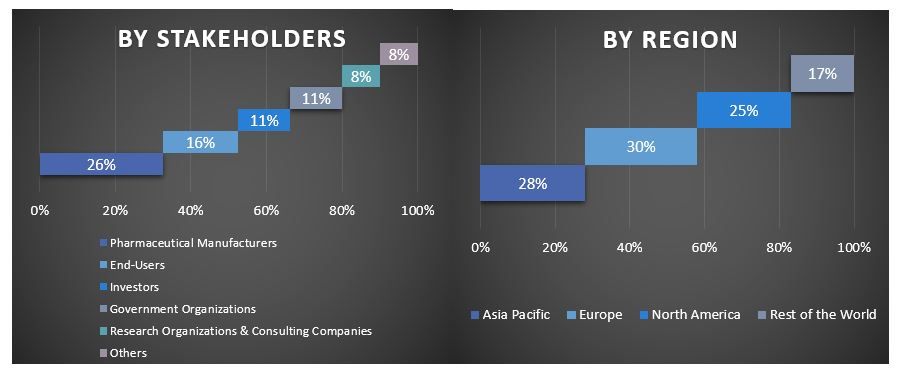
Kỹ thuật Thị trường
Kỹ thuật phân tích dữ liệu đã được sử dụng để hoàn thành ước tính thị trường tổng thể và để đưa ra các số liệu thống kê chính xác cho từng phân khúc và phân khúc phụ của thị trường điều trị rối loạn sử dụng opioid (OUD) toàn cầu. Dữ liệu được chia thành nhiều phân khúc và phân khúc phụ sau khi nghiên cứu các thông số và xu hướng khác nhau trong các lĩnh vực loại thuốc, đường dùng, kênh phân phối và khu vực trong thị trường điều trị rối loạn sử dụng opioid (OUD) toàn cầu.
Mục tiêu chính của Nghiên cứu Thị trường Điều trị Rối loạn Sử dụng Opioid (OUD) Toàn cầu
Các xu hướng thị trường hiện tại & tương lai của thị trường điều trị rối loạn sử dụng opioid (OUD) toàn cầu đã được xác định trong nghiên cứu. Các nhà đầu tư có thể thu được những hiểu biết sâu sắc chiến lược để dựa vào quyết định của họ cho các khoản đầu tư vào phân tích định tính và định lượng được thực hiện trong nghiên cứu. Các xu hướng thị trường hiện tại và tương lai xác định sự hấp dẫn tổng thể của thị trường ở cấp độ khu vực, cung cấp một nền tảng cho người tham gia công nghiệp khai thác thị trường chưa được khai thác để hưởng lợi từ lợi thế của người đi đầu. Các mục tiêu định lượng khác của nghiên cứu bao gồm:
- Phân tích quy mô thị trường hiện tại và dự báo của thị trường điều trị rối loạn sử dụng opioid (OUD) về giá trị (USD). Ngoài ra, hãy phân tích quy mô thị trường hiện tại và dự báo của các phân khúc và phân khúc phụ khác nhau.
- Các phân khúc trong nghiên cứu bao gồm các lĩnh vực loại thuốc, đường dùng, kênh phân phối và khu vực.
- Xác định và phân tích khuôn khổ pháp lý cho việc điều trị rối loạn sử dụng opioid (OUD)
- Phân tích chuỗi giá trị liên quan đến sự hiện diện của các trung gian khác nhau, cùng với việc phân tích hành vi của khách hàng và đối thủ cạnh tranh trong ngành.
- Phân tích quy mô thị trường hiện tại và dự báo của thị trường điều trị rối loạn sử dụng opioid (OUD) cho khu vực chính.
- Các quốc gia chính của các khu vực được nghiên cứu trong báo cáo bao gồm Châu Á Thái Bình Dương, Châu Âu, Bắc Mỹ và Phần còn lại của Thế giới
- Hồ sơ công ty của thị trường điều trị rối loạn sử dụng opioid (OUD) và các chiến lược tăng trưởng được các nhà cung cấp thị trường áp dụng để duy trì trong thị trường đang phát triển nhanh chóng.
- Phân tích sâu ở cấp độ khu vực của ngành.
Câu hỏi thường gặp Câu hỏi thường gặp
Câu hỏi 1: Quy mô thị trường hiện tại và tiềm năng tăng trưởng của thị trường điều trị rối loạn sử dụng opioid (OUD) là gì?
Q2: Đâu là những yếu tố thúc đẩy sự tăng trưởng của thị trường điều trị rối loạn sử dụng opioid (OUD)?
Q3: Phân khúc nào chiếm thị phần lớn nhất trong thị trường điều trị rối loạn sử dụng opioid (OUD) theo nhóm thuốc?
Q4: Các công nghệ và xu hướng mới nổi trong thị trường điều trị rối loạn sử dụng opioid (OUD) là gì?
Q5: Khu vực nào sẽ chiếm ưu thế trên thị trường điều trị rối loạn sử dụng opioid (OUD)?
Liên quan Báo cáo
Khách hàng đã mua mặt hàng này cũng đã mua










